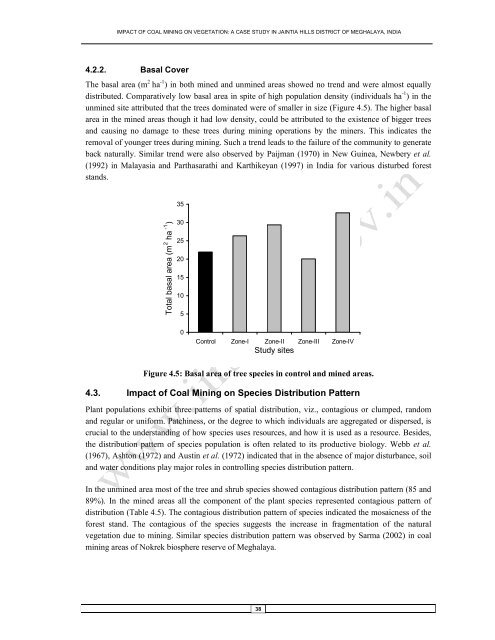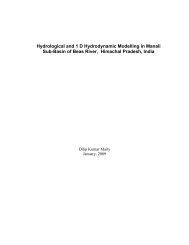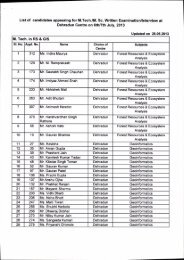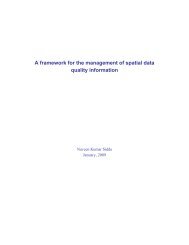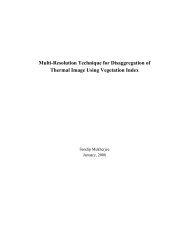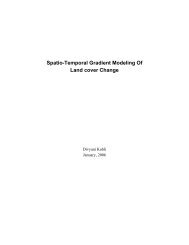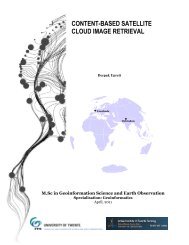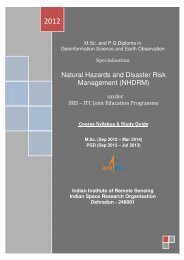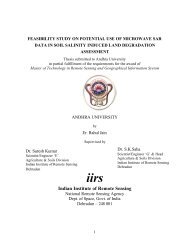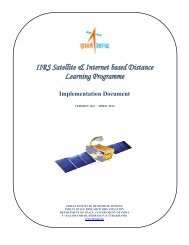Impact of Coal Mining on Vegetation: A Case Study in Jaintia Hills ...
Impact of Coal Mining on Vegetation: A Case Study in Jaintia Hills ...
Impact of Coal Mining on Vegetation: A Case Study in Jaintia Hills ...
Create successful ePaper yourself
Turn your PDF publications into a flip-book with our unique Google optimized e-Paper software.
IMPACT OF COAL MINING ON VEGETATION: A CASE STUDY IN JAINTIA HILLS DISTRICT OF MEGHALAYA, INDIA4.2.2. Basal CoverThe basal area (m 2 ha -1 ) <strong>in</strong> both m<strong>in</strong>ed and unm<strong>in</strong>ed areas showed no trend and were almost equallydistributed. Comparatively low basal area <strong>in</strong> spite <str<strong>on</strong>g>of</str<strong>on</strong>g> high populati<strong>on</strong> density (<strong>in</strong>dividuals ha -1 ) <strong>in</strong> theunm<strong>in</strong>ed site attributed that the trees dom<strong>in</strong>ated were <str<strong>on</strong>g>of</str<strong>on</strong>g> smaller <strong>in</strong> size (Figure 4.5). The higher basalarea <strong>in</strong> the m<strong>in</strong>ed areas though it had low density, could be attributed to the existence <str<strong>on</strong>g>of</str<strong>on</strong>g> bigger treesand caus<strong>in</strong>g no damage to these trees dur<strong>in</strong>g m<strong>in</strong><strong>in</strong>g operati<strong>on</strong>s by the m<strong>in</strong>ers. This <strong>in</strong>dicates theremoval <str<strong>on</strong>g>of</str<strong>on</strong>g> younger trees dur<strong>in</strong>g m<strong>in</strong><strong>in</strong>g. Such a trend leads to the failure <str<strong>on</strong>g>of</str<strong>on</strong>g> the community to generateback naturally. Similar trend were also observed by Paijman (1970) <strong>in</strong> New Gu<strong>in</strong>ea, Newbery et al.(1992) <strong>in</strong> Malayasia and Parthasarathi and Karthikeyan (1997) <strong>in</strong> India for various disturbed foreststands.35Total basal area (m 2 ha -1 )302520151050C<strong>on</strong>trol Z<strong>on</strong>e-I Z<strong>on</strong>e-II Z<strong>on</strong>e-III Z<strong>on</strong>e-IV<strong>Study</strong> sitesFigure 4.5: Basal area <str<strong>on</strong>g>of</str<strong>on</strong>g> tree species <strong>in</strong> c<strong>on</strong>trol and m<strong>in</strong>ed areas.4.3. <str<strong>on</strong>g>Impact</str<strong>on</strong>g> <str<strong>on</strong>g>of</str<strong>on</strong>g> <str<strong>on</strong>g>Coal</str<strong>on</strong>g> <str<strong>on</strong>g>M<strong>in</strong><strong>in</strong>g</str<strong>on</strong>g> <strong>on</strong> Species Distributi<strong>on</strong> PatternPlant populati<strong>on</strong>s exhibit three patterns <str<strong>on</strong>g>of</str<strong>on</strong>g> spatial distributi<strong>on</strong>, viz., c<strong>on</strong>tagious or clumped, randomand regular or uniform. Patch<strong>in</strong>ess, or the degree to which <strong>in</strong>dividuals are aggregated or dispersed, iscrucial to the understand<strong>in</strong>g <str<strong>on</strong>g>of</str<strong>on</strong>g> how species uses resources, and how it is used as a resource. Besides,the distributi<strong>on</strong> pattern <str<strong>on</strong>g>of</str<strong>on</strong>g> species populati<strong>on</strong> is <str<strong>on</strong>g>of</str<strong>on</strong>g>ten related to its productive biology. Webb et al.(1967), Asht<strong>on</strong> (1972) and Aust<strong>in</strong> et al. (1972) <strong>in</strong>dicated that <strong>in</strong> the absence <str<strong>on</strong>g>of</str<strong>on</strong>g> major disturbance, soiland water c<strong>on</strong>diti<strong>on</strong>s play major roles <strong>in</strong> c<strong>on</strong>troll<strong>in</strong>g species distributi<strong>on</strong> pattern.In the unm<strong>in</strong>ed area most <str<strong>on</strong>g>of</str<strong>on</strong>g> the tree and shrub species showed c<strong>on</strong>tagious distributi<strong>on</strong> pattern (85 and89%). In the m<strong>in</strong>ed areas all the comp<strong>on</strong>ent <str<strong>on</strong>g>of</str<strong>on</strong>g> the plant species represented c<strong>on</strong>tagious pattern <str<strong>on</strong>g>of</str<strong>on</strong>g>distributi<strong>on</strong> (Table 4.5). The c<strong>on</strong>tagious distributi<strong>on</strong> pattern <str<strong>on</strong>g>of</str<strong>on</strong>g> species <strong>in</strong>dicated the mosaicness <str<strong>on</strong>g>of</str<strong>on</strong>g> theforest stand. The c<strong>on</strong>tagious <str<strong>on</strong>g>of</str<strong>on</strong>g> the species suggests the <strong>in</strong>crease <strong>in</strong> fragmentati<strong>on</strong> <str<strong>on</strong>g>of</str<strong>on</strong>g> the naturalvegetati<strong>on</strong> due to m<strong>in</strong><strong>in</strong>g. Similar species distributi<strong>on</strong> pattern was observed by Sarma (2002) <strong>in</strong> coalm<strong>in</strong><strong>in</strong>g areas <str<strong>on</strong>g>of</str<strong>on</strong>g> Nokrek biosphere reserve <str<strong>on</strong>g>of</str<strong>on</strong>g> Meghalaya.38


